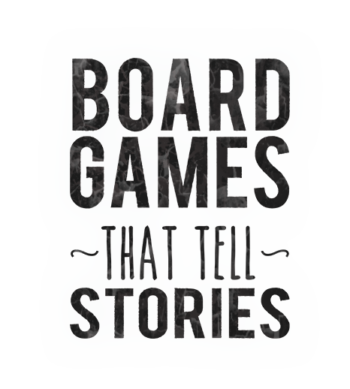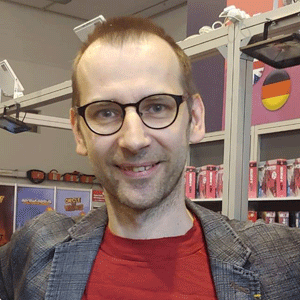Magic Moments in Playtesting
Here is a guest post by Charles Beauvais.
It’s GDJ about his designs. Find them on KS here!
To appreciate the following stories, you’ll need to know a bit about the mechanics of the game, Smoke and Mirrors. There are three suits, each of which has a different distribution of cards. Each player gets one card from each suit as their hand.
Star: 1 1 1 1 1 Mirror
Spiral: 1 2 3 4 5 Mirror
Skull: 5 5 5 5 5 Mirror
In playtesting, most players pick up the pattern after a round or two. Stars are (usually) 1, Skulls are (usually) 5, and each Spiral card is unique. So, if you’ve got the Spiral 3, and someone puts down a single Spiral card claiming a total of 3, you know they are lying.
Mirrors, by the way, copy one or two of the other (non-mirror) cards it’s played with.
MAGIC PLAYTESTING MOMENT #1: Manny’s Impossible Bluff
In an early version of the game, everyone (not just the next player) had the option of calling your bluff. Manny claimed a total of 4, and put down a single Skull card.
Consulting the chart above, you’ll see that no Skull card has a value of 4, so he was clearly lying. Watching the game silently, I expected the next player would call him out, and that would be the end of it.
However, the next player was too preoccupied with figuring out his turn to notice Manny’s mistake, and he played without challenging. The following player likewise didn’t challenge Manny. There was only one player left before it would be Manny’s turn again: Gabriel.
Gabriel has noticed Manny’s misplay. He knew that it was impossible. And yet… he had just seen two other players decline to call him on it. Gabriel paused, took a deep breath, and accused Manny of lying.
After the game, I asked Manny why he had played a Skull, when he knew that it was impossible. He admitted to simply grabbing the wrong card from his hand! He was as surprised as anyone to see his Skull card (instead of his Spiral card) on the table, but felt that it would arouse too much suspicion to pick it back up. His audacity almost paid off.
MAGIC PLAYTESTING MOMENT #2: Loser’s Revenge
Weeks later, Jim and Brian were losing badly to Gabriel (who had won five rounds in a row). Jim puts down a Spiral card and claims “2”. Brian doesn’t call Jim.
Brian puts down a Star and Spiral card and claims “3”. Gabriel looks at Brian and says, „The only way to form a total of 3 with those cards is if the Spiral card had a value of 2. But, if you were holding the Spiral 2, you would have called Jim when he claimed to have the Spiral 2. You’re obviously lying.”
But Brian was telling the truth! Even though he knew Jim was lying about having the Spiral 2, he didn’t call Jim in order to set a trap for Gabriel.
DIGRESSION ON GROUP-THINK
On the one hand, Smoke and Mirrors is open to analysis. There are 216 possible hands, but that includes a lot of duplication. There are only 24 unique hands. You have a great chance (93%) of being able to produce a 5, and not a very good chance (33%) of producing a 3. But this doesn’t matter.
Your group might arrive at the (mathematically justified) conclusion: “Never claim a 3, unless you have it” is a good heuristic for the game. You all smile and nod and agree, yes, 33% is far too unlikely, you should never bluff a 3. Then you deal out the cards and, suddenly, the player before you claims to have a 3. Is she lying?
The mathematical analysis, the theory, the discussion, the sensible agreement all go out the window. Certainly, she knows that bluffing a 3 is always a bad play, so she’s not bluffing. But, maybe she’s counting on you using this logic to get away with bluffing. She’s won the last two rounds, so she wouldn’t risk throwing it all away on such a transparent bluff, would she?
MAGIC PLAYTESTING MOMENT #3: Pride goeth before the fall
The dialogue in this story speaks for itself.
Manny: (calling Jim’s bluff) „You’re lying. You know how I know?”
Jim: (revealing his winning hand) „You don’t know.”
Smoke and Mirrors is one of three new games in the ButtonShy wallet series. All three are on Kickstarter right now!


 I strongly believe that good board game is the one that tells a good story. You play it and suddenly you are sucked into it, you feel chills on the skin. Emotions grow. In a moment you defend castle. You hear roar of warriors. You smell boiling oil. You are into it.
That's how I design my games. I always want to tell a good story. I want players to be into it. As deep as possible.
I strongly believe that good board game is the one that tells a good story. You play it and suddenly you are sucked into it, you feel chills on the skin. Emotions grow. In a moment you defend castle. You hear roar of warriors. You smell boiling oil. You are into it.
That's how I design my games. I always want to tell a good story. I want players to be into it. As deep as possible.




Thanks for posting this, Ignacy!
Sounds fun. There must be a ton of interactions such as these with the playtesting of the game. What were some of the feedback you looked for from playtesters?
That’s a good question, possibly worth an article on its own! Here’s the top three things I look for.
1. Do the players understand the rules?
Are they playing correctly? Are they making moves that don’t make sense? (like the example of grabbing the wrong cards)
Players never say, „My understanding of the rules is in error”, so this has to be determined by observation.
2. Does the game work?
I look for signs of confusion, hesitation, frustration, or aimlessness. Even if the players know how to go through the motions, it doesn’t mean they have an objective. I listen for people saying, „I’ll do this, but I don’t know why.”
3. Where is the fun?
It’s not always where I expect. I’ll follow the playtester’s lead here. I don’t want my plan of where the fun should be blind me to where the players are finding fun.